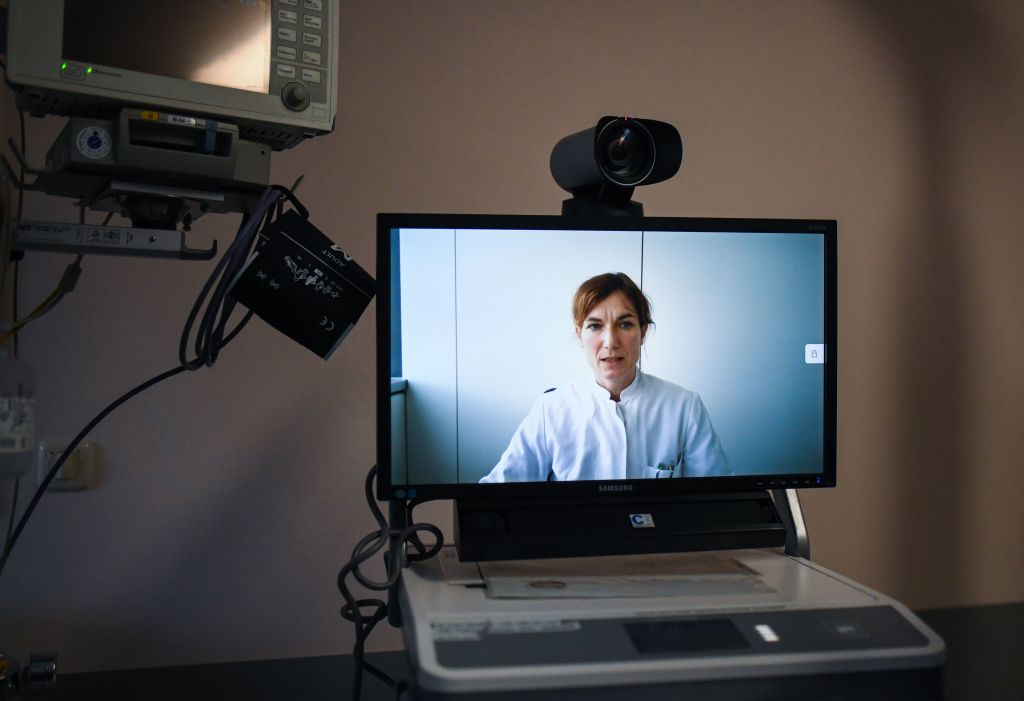Where have all the GPs gone? Doctors were among the first to be double-jabbed, ahead of teachers in the queue precisely so they could resume seeing patients in the flesh. But while schools have long been back, GPs have retreated behind their laptops never to be seen again (at least not in the flesh). The stethoscope has been replaced by a headset — to the despair of patients with ailments that are hard to diagnose over the phone or via a laptop.
In theory, GPs can claim normal service has resumed. In the pandemic the number of appointments almost halved to just over three million a week — in spite of attempts to keep healthcare running. The consequences of this drop can only be guessed at. The problem with ministers urging us to ‘protect the NHS’ by not using it is that people don’t seek medical care, including cancer diagnoses. And that will kill, as surely as Covid.
GPs say consultations are now back to the normal level of six million a week. But look into the figures and you can see a big flaw: the number of face-to-face appointments is way down since the pandemic began, with 1.5 million fewer in-person appointments each week. They have been replaced by telephone appointments. Their number has tripled, from about 850,000 per week pre-pandemic to about 2.3 million a week now.

This is not driven by patient demand: it’s a downgrade of a vital public service. Under pandemic guidance, GP surgeries had been advised to offer telephone triage first, and then face-to-face appointments if deemed ‘clinically necessary’. What constitutes ‘necessary’ remains open to interpretation. While many GPs have been willing to offer patients either telephone or in–person appointments, depending on what they prefer, others appear to have moved almost entirely to virtual ones.
What possible justification can GPs give for not resuming in-person appointments? Now that the vaccine has been rolled out, surely this is something that should be prioritised. Given the impact lockdown has had on people accessing healthcare, ensuring that GP surgeries are back up and running as usual should be paramount. Yet some GPs seem to be dragging their feet. Sure, I get it, working from home has been a breath of fresh air for many people. It’s shown them a different way of working. But medicine isn’t like a job in marketing. It’s serious.
An actual GP appointment in person has become something that’s considered almost quaint
An actual GP appointment, where you sit down in front of a doctor, is now vanishingly rare in some areas. In just 18 months it’s become something that’s considered almost quaint. It’s a complaint I have heard time and time again from my own patients in mental health when they have tried to see their GP. The situation has left hospital doctors such as myself baffled, because the rest of the NHS has started to open up. In mental health I have almost entirely abandoned phone appointments, because it just isn’t the same. So much is lost from the clinical encounter when it’s done over the phone. And the majority of patients didn’t just prefer seeing someone in person, they actively hated appointments conducted over the phone. Of course, there will always be people who prefer the convenience of a Skype or phone call. But they tend to be those with simple, straightforward problems. In-out type cases.
What about all the people with complex problems? With difficult, nuanced, multifaceted conditions? Things where you need to examine the patient, or you get a hunch just by looking at them. You know, the stuff that doctors have actually trained to be good at?
This isn’t about GP-bashing. This is about standing up for patients whose voices all too often aren’t heard and insisting that doctors listen to them. The NHS has this week directed GPs to see children with coughs or breathing problems face to face, and refer them to a specialist if necessary. But it’s odd that they need to be told.
What really gets to me is that we all know the people who will suffer — it will be the old, the poor, the mentally ill, the disenfranchised. They don’t form Twitter campaigns or launch legal action or even write letters of complaint. They just sit at home wondering if that strange pain in their chest that’s been there every time they walk up the stairs is anything to worry about, or the odd lump that’s appeared in their armpit is just a swollen gland. This situation is why the poor die younger than the rich and why the response from primary care, if it continues to refuse to see people face-to-face, will mean that this gross inequity will be magnified again and again.
It’s been argued that the shift to telephone appointments is actually good for the NHS. It’s more efficient. Yet the data doesn’t support this. Despite the move to phone consultations, the proportion of same-day appointments taking place has barely changed. It was about 40 per cent pre-pandemic and is about 43 per cent now. So there has been no meaningful increase in efficiency at all.
Yes, the pandemic has been difficult and trying on those in the health service. But really, there is no excuse not to start to see patients in person. It’s what the vast majority really want. I think it’s also telling that the private sector hasn’t seen the same reluctance to resume meeting patients face to face. Quite the opposite, in fact. Private doctors quickly realised that this is what patients wanted and were back behind their desks as soon as they were allowed. Friends who work privately talk of doing a roaring trade in patients who actually want to see a doctor rather than try to explain their problem to a distant voice over the phone. Why doesn’t this stick in the craw of NHS GPs who surely can see how the pandemic has already deepened inequality, and how refusing to see patients face-to-face is creating a two-tier system whereby those who can afford it are simply going elsewhere?
At first, I was astonished at the way general practice responded to the pandemic. It organised itself at lightning speed and it was inspiring to see GPs pull together and mobilise in this way. They put many hospitals to shame in how quickly they adapted. But now something has changed. In hindsight, I can’t help but wonder if the pandemic didn’t tap into something that already existed. GPs, already frustrated and frazzled, have been given a taste of a different pace and lifestyle which means they can have the flexibility and ease of logging in from home and the peace of a surgery not crammed with moaning, wailing patients.
But I fear that if GPs continue in this vein, they’ll be destroying their credibility. They’ll lose the public’s goodwill that has been built up over the pandemic, and that will damage the NHS, as people will start to question whether the health service really has their best interests at heart. Patients describe delays and frustration trying to get through on the phone, being refused face-to-face appointments and struggling to deal with new technology such as video consultations and online booking systems.
General practice often comes in for criticism from the public. Most of it is unfair, given the tremendous stresses and strains GPs face. But those who refuse to see patients in person do absolutely nothing to ingratiate themselves with the public. In fact, they feed directly into the suspicion among some that many GPs have long-viewed their patients with a certain disdain and irritation. It makes them look self-centred and un-interested. What a tragedy it would be if this became the prevailing view of modern general practice. The old complaint of never seeing the same GP twice has been replaced with a far more serious one — never seeing the GP at all.






Comments